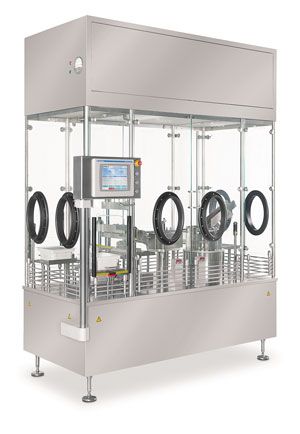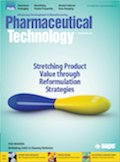Parenteral Packaging Advances
Manufacturers of parenteral drugs face challenges to increase efficiency, control particulates, control extractables and leachables, and eliminate product/package interactions; new containers and packaging equipment offer increased options.
Manufacturers of parenteral drugs face many challenges, particularly in light of the expanding population of more sensitive biopharmaceuticals. With smaller batch sizes and a need to control particulates and extractables and leachables, the industry is seeking more flexible equipment and new material options.
Due to their biological foundation, biopharmaceuticals tend to be fragile and susceptible to product/package interactions. To eliminate negative interactions, materials must be carefully sourced and tested.
With biologics, assumptions made about materials may not be valid. “Things we assume are safe, may not necessarily be safe,” says Andy Polywacz, vice-president of quality and regulatory affairs at West Pharmaceutical Services, a supplier of components and systems for injectable drug delivery. He explains, “Every molecule is different. Sterilization has an impact on formula shelf life and extractables. The effect of gamma and steam [sterilization] could be different. The design of the container/closure needs to be assessed. A standard plunger may not be suitable. The historical design may not work in a new delivery system.” As a result, there’s strong interest in materials and components that deliver a lower extractables and leachables profile.
Material options
In containers, cyclic olefin copolymer (COC) is receiving a lot of attention due to its inert nature and glass-like transparency. Christopher Cassidy, vice-president of sales and marketing, North America, at Schott, a supplier of glass and polymeric parenteral packaging, says the polymeric packaging is break-resistant, withstands higher-force syringes, doesn’t darken when exposed to gamma sterilization, and is easier to form for custom designs and larger syringes with volumes more than 10 mL.
COC is the basis for the Schott TopPac SD prefillable syringe system. Designed to ensure stability of sensitive drugs and compress time to market, careful component selection and processing minimize extractables and leachables. COC barrels release no ions or heavy metals and reduce chances of a chemical interaction with sensitive drugs. Pure elastomer components and steam sterilization of plungers also help minimize extractables and leachables. For the same reason, ethylene oxide sterilization is used rather than gamma for the barrel and tip cap. In addition, cross-linked silicone significantly reduces sub-visible particles while retaining lubrication performance. Fully integrated cleanroom production results in syringes with low particles and low contamination. Other TopPac SD syringe advantages include standard tub and nest offering and integrated luer lock. It’s also compatible with needleless intravenous connectors (1).
For enhanced protection of the drug product, Clariant’s Masterbatches unit supplies Mevopur ultraviolet (UV) filters and absorbers for COC resin. The material blocks product-degrading UV light and is available in a range of colors. To make the transition to COC easier, Clariant has completed extractables and leachables testing.
To limit interaction with proteins and elastomeric stoppers, Aptar Stelmi applies a thin fluoropolymer coating. The PremiumCoat stopper provides a barrier to extractables and leachables that can be released from the elastomer and contaminate the drug. Produced in 13-mm and 20-mm diameters, the PremiumCoat stopper is available worldwide. Target applications include cytotoxic drugs used in cancer therapies, novel vaccines, blood derivatives, hormones, and compounds used to treat auto-immune diseases, including monoclonal antibodies (2).
Particulate control is important too, because particulate contamination continues to be the reason behind many recalls. A new syringe line installed by Nipro in Germany laser-cuts tubular glass to minimize particulate generation. In addition, Nipro has installed 100% (rather than random) siliconization inspection. Toward the end of the line, an x-ray inspection captures two images of each syringe to confirm the needle is not bent or piercing the shield.
Attention to particulate generation from the beginning of the supply chain is essential. The further back in the supply chain particulate generation occurs, the greater the number of finished products likely to be affected. With needs outpacing legacy capability, “Investments in equipment need to be made,” says Jennifer Riter, senior director of global analytical services at West Pharmaceutical Services. West’s ready-to-sterilize products come with a particulate guarantee based on particle size, so manufacturers can determine how it will affect their process.
When controlling particulates, parenteral product manufacturers must consider whether they removed or added any particulates during the manufacturing process. In addition, manufacturers must choose automated or manual particle counting. Manual counting has advantages because the eye can identify hard-to-distinguish particles from materials such as polyethylene and elastomer or the product itself. “Automation has to have the right hardware and software,” says Riter.
Ready-to-fill lines
Exhibitors at INTERPHEX (April 21–23, 2015 in New York, NY) featured ready-to-fill (or ready-to-use) vials, cartridges, and/or syringes in nests, or machines designed to handle this format. Although ready-to-fill syringes have been available for some time, ready-to-fill vials are just beginning to come on the market. Prefilled syringes answer the need for easier administration, in some cases enabling self-administration. Cost is also a driver in the transition to prefilled syringes, according to Steve Hourmezian, West Coast sales manager at Nipro Glass Americas, a global maker of ampules, vials, syringes, cartridges, and specialty products. “Prefilled syringes offer longer shelf life and less handling at point of administration,” he explains.
Handling vials in nests and trays prevents glass-to-glass contact, glass-to-machine contact, scratches, and potential breakage better than traditional bulk packaging or shrink-film bricks. Minimizing contact not only reduces reject rates, but also preserves the cosmetic quality of the containers.
Ready-to-fill containers offer the potential for cost savings due to increased flexibility and reductions in equipment, labor, and turnaround time. Because arriving containers are clean, sterile, and depyrogenated, the end user doesn’t need washing equipment, water-for-injection systems, or depyrogenation tunnels along with related labor and floor space. In addition, eliminating these steps saves time and reduces validation and maintenance requirements. Less handling also reduces particle generation and lowers the risk of stops and downtime.
Now available from several sources, ready-to-fill options include ez-fill vials, cartridges, and syringes from Ompi. Vials may be ordered in a variety of diameters, heights, and crimp finishes and can be delivered in nest and tub or tray/light-tray packaging. The 3-mL ez-fill cartridges can be supplied capped or uncapped in a nest and tub (3). The ez-fill syringe range includes a glass option for more sensitive products, a choice of staked needle or luer, as well as a variety of sizes and closure styles. Needle sizes range from 22 to 29 G with lengths from 0.5 to 1 in. Plunger options include ready-to-sterilize, pre-sterilized, or coated plungers (4).
Schott also offers ready-to-fill syringes and vials. Its adaptiQ vials are especially well suited to clinical trials and smaller batch sizes and are being qualified by several customers. A patented nest securely holds up to 100 clean and sterile vials in an industry-standard tub. “Many pharmaceutical manufacturers aren’t set up to wash and sterilize smaller volumes,” explains Christopher Cassidy, Schott’s vice-president Sales and Marketing, North America. Available in 2-, 4-, 6-, 8-, 10-, 15-, 20-, 25-, and 30-mL sizes, the ready-to-fill adaptiQ containers also offer benefits to contract packagers by allowing them to focus on the product rather than setup and validation of washing and sterilizing operations.
Figure 1. The Dara SFL syringe filling and plugging machine from NJM Packaging handles nested glass or plastic syringes or vials, operates with several filling and barrier options, and can be configured for duplex operation. Image is courtesy of NJM Packaging.

Although prefilled syringe lines may be able to handle nests of vials, transitioning to ready-to-fill vials could require new filling and closing equipment. There are several flexible machines available to handle trayed or nested containers. Equipment for ready-to-fill parenteral packaging tends to be modular. For example, the compact 72 x 36 in. (183 x 91 cm) Dara SFL syringe filling and plugging machine from NJM Packaging can be equipped with an isolation barrier or restricted access barrier (RAB). Capable of handling glass or plastic, filling options include a peristaltic pump or valveless rotary piston pump. Fill volumes range from 0.5 to 20 mL for syringes and 0.5 to 50 mL for vials. Operators load and remove nests or trays of syringes or vials at entrance and exit pass-boxes. Filling and closing occurs at up to 35 units per min. on a 1-mL fill. For higher speed requirements, a duplex unit handles up to 80 units per min. Changeover is recipe-driven, requires no tools, and takes less than 10 minutes. An easy-to-use operator interface simplifies input parameters for handling a different package type and/or size with a different tray configuration. A one-head system can be converted to a two-head system in the field as volume grows. Options include a clean-in-place system, a sterilize-in-place system, and gas flushing (5).
The intermittent-motion Optima H4 filling and closing machine handles nested syringes, vials, and cartridges at a rate of up to 600 per min. The modular system can be equipped with time pressure, rotary piston, or peristaltic pumps and is easily upgraded as needs change. Retrofitting vacuum filling and stopper insertion as well as in-process controls is an option. The system displayed at INTERPHEX featured an open RAB containment system, but a closed RAB system or isolator also could be installed. During operation, when the tub arrives from the debagger, the Tyvek removal robot pulls the lid off and puts it in a bin. The open tub indexes, and the nest is lifted out and placed in frame for filling and stoppering. Ten vials are filled at a time. Fills range from 0.5 mL to 20 mL for syringes and up to 50 mL for vials. Cartridge fills measure 3 mL. After stoppering, the nest is replaced in the tub, and it moves on for plunger insertion, labeling, and other post-filling operations (6).
Handling nests of containers for parenteral products often depends on a robot. In fact, “Robot filling is a major trend,” reports Biljana Medic Taddei, sales engineer at Vanrx Pharmasystems. Robots also load and unload the company’s lyophilizer interface. The series of workcells transfer nested vials from a Vanrx SA25 aseptic filling workcell to a freeze-dryer. The digitally driven, bridgeless loading system requires no conveyors or gloves and starts up with the push of a button.
References
- Schott North America, “Schott TopPac SD,” Product Brochure, undated.
- Aptar Stelmi, “Aptar Stelmi Unveils PremiumCoat Coated Stoppers for Sensitive and High-Value Injectables,” Press Release, Feb. 11, 2015.
- Ompi, “Ez-fill Vials & Cartridges,” Product Sheet, August 2014.
- Ompi, “Ez-fill Syringes,” Product Sheet, July 2014.
- NJM Packaging, “NJM Packaging Introduces the Dara SFL Aseptic Syringe Filling and Plugging System,” Press Release, Mar. 31, 2015.
- Optima, “Filling and Closing Machine for Nested Syringes, Vials and Cartridges, Optima H4,” Product Brochure, undated.
Article DetailsPharmaceutical Technology
Vol. 39, No. 10
Pages: 78–81
Citation:
When referring to this article, please cite it as H. Forcinio, "Parenteral Packaging Advances," Pharmaceutical Technology 39 (10) 2015.

Pharmaceutical Tariffs Are Imminent: How Industry is Bracing for Impact
April 16th 2025On April 14, 2025, the Trump Administration launched a national security-driven investigation into pharmaceuticals, a move that will likely result in tariffs being placed on pharmaceutical drugs, ingredients, and other components that are imported from outside of the United States.
Drug Solutions Podcast: A Closer Look at mRNA in Oncology and Vaccines
April 30th 2024In this episode fo the Drug Solutions Podcast, etherna’s vice-president of Technology and Innovation, Stefaan De Koker, discusses the merits and challenges of using mRNA as the foundation for therapeutics in oncology as well as for vaccines.